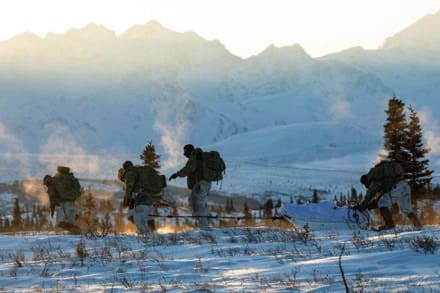
FORT GREELY, Alaska — Deployed Soldiers are constantly loaded down with gear, but nowhere more so than when operating in a cold weather environment.
In addition to their conventional weapons, Soldiers need to utilize heavy equipment like space heaters, cooking stoves, fuel and heavy-duty thermal tents to survive operations in the Arctic.
Candidates to serve as the Army’s Arctic Mobility Sustainment System underwent rigorous testing at U.S. Army Cold Regions Test Center, or CRTC, this winter with the help of Soldiers from the Army’s 11th Airborne stationed at Joint Base Elmendorf-Richardson, Washington.
“When they go out in zone seven operations, this is the new stuff they will be pulling out there with them to set up shelters,” said Danielle Schmidt, assistant test officer. “We went through a lot of changes since the test started up here all based on learning what works and what doesn’t in the cold.”
The system selected as a result of this testing will eventually replace the legacy Ahkio sled and 10-person tent the Army currently uses. Testers expected and coveted extreme cold for the multi-week test, with the interior Alaska winter delivered more than they expected.
“The whole time the test was going it didn’t get above minus 20 Fahrenheit,” said Isaac Howell, senior test officer. “It was good test conditions for what we were doing, but it was difficult on the Soldiers. Sustained movement in the Arctic day in and day out at those temperatures is not easy.”
On a typical day Soldiers would pack the Arctic Mobility Sustainment System sled under test with the tent, a heater and their basic standard issue items for Arctic infantry operations. The Soldiers would then pull the sleds in either nine-Soldier squads or four to five Soldier teams with CRTC’s test personnel led the way. Moving the heavy sleds across CRTC’s hilly tundra and thickly forested areas is challenging in any conditions, but particularly so in the extreme cold and deep snow of winter.
“Our snow is so dry and powdery,” said Howell. “You don’t stand on it at all, whether you are in skis or snowshoes — you don’t go across the top of it, you go through it. You are plowing snow the entire day regardless of whether you are wearing snowshoes or not.”
After a two-and-a-half-hour movement, testers kept track of how long it took the Soldiers to emplace and erect each tent and get the space heaters operating. Following a cold weather Meal Ready to Eat for lunch, the Soldiers disassembled the tent and heater and returned to their day’s starting point following a different route. Following a survey and hot meal, the Soldiers reassembled the tents and heaters and prepared to sleep in the long, cold Arctic nights, which sometimes approached minus 50 degrees Fahrenheit.
“The Soldiers were instrumented for safety purposes to make sure they didn’t get too cold or hypothermic,” said Schmidt. “If they did get too cold, they could pull themselves. We had noxious gas sensors in the tents where the heaters were operating as another safety precaution.”
Despite the hardships, the participating Soldiers gave high marks to CRTC’s test crew.
“It was pretty cool being able to experience that and see what all the new equipment is like,” said Pvt. 1st Class Tyler Worrell.
By Mark Schauer

